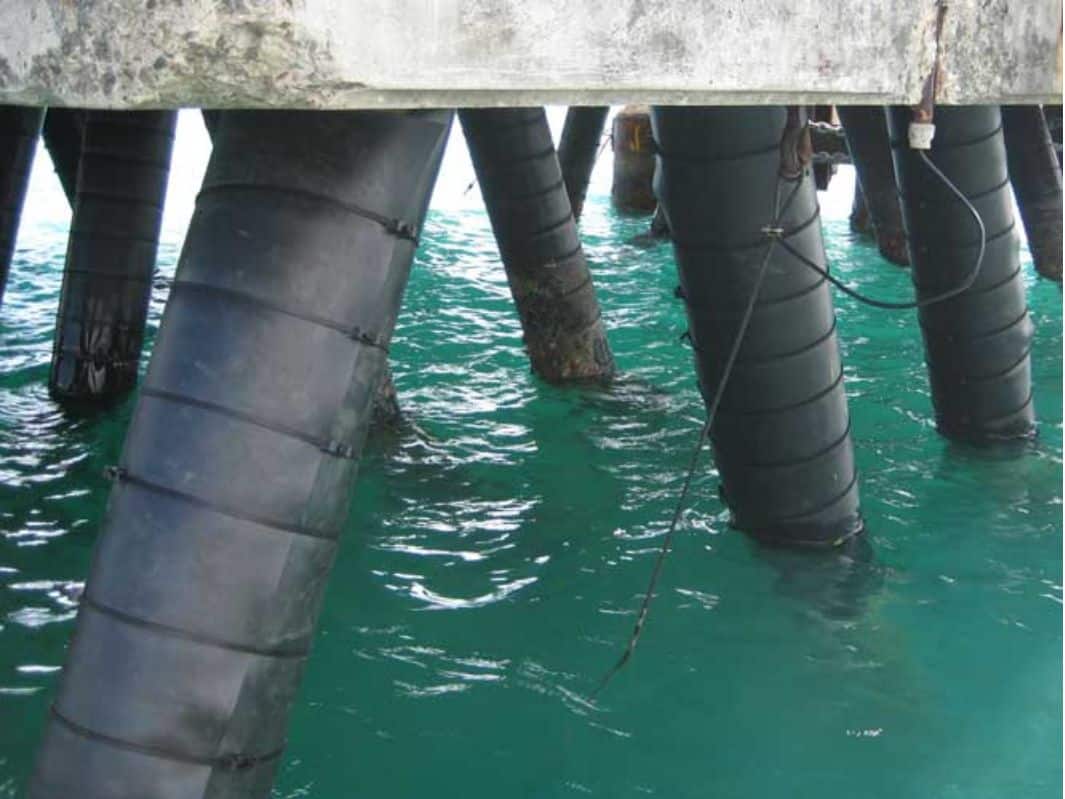
The Ultimate Guide to Marine Piling and Pile Protection: Innovative Solutions for Longevity and Durability
In the challenging realm of marine construction and piling, safeguarding piles is not just crucial—it is imperative for the endurance and security of structures battling harsh aquatic conditions. The process of piling and the subsequent protection of steel piles, concrete piles, and timber piles face relentless assault from corrosive elements, aggressive marine organisms, and the constant wear of environmental factors. For entities dependent on these vital piling structures, implementing robust protection and repair solutions is not merely an option; it’s an absolute necessity for long-term sustainability and safety in marine piling projects.
This comprehensive guide delves into an array of cutting-edge solutions designed to protect and repair marine pilings. We will focus on state-of-the-art systems engineered to withstand the most unforgiving marine environments. Regardless of your pile material—be it steel piling, concrete piling, or timber piles—these advanced systems provide all-encompassing protection and repair strategies, significantly boosting the longevity and resilience of your marine infrastructures.
The Origins of Piling
The history of piling construction dates to ancient times when people ingeniously used piles for constructing foundations on weak peat soils near rivers. Many early settlements were strategically located near water bodies for access to water and natural protection. To combat weak bearing ground, our ancestors reinforced these areas using timber piles that were either manually forced into the ground, or fixed in holes that were filled with stones and sand.
In Britain, many examples of the Romans using timber piles in bridge works still exist, showing this technique’s longevity. During medieval times, piles of oak and alder were used in the foundations of the great monasteries constructed in the fenlands of East Anglia. Timber, because of its strength combined with lightness, durability, and ease of cutting and handling, remained the only material used for piling until comparatively recent times.
What is Piling?
Piling, also known as pile driving, is a fundamental aspect of construction. The meaning of piling in construction refers to the process of installing deep foundations, known as piles. These piles are structural elements that transfer loads from a structure to deeper, more stable layers of soil or rock. Piling construction work involves driving, drilling, or boring these piles into the ground to support buildings, bridges, and other structures.
Piling foundations are used when the soil near the surface is too weak to support the weight of a structure. The piles transfer the load to solid ground located at a depth, ensuring stability and safety for structures built above. This technique is crucial in areas with poor soil conditions or where heavy loads need to be supported.
Types of Piling
There are several types of piles used in construction, each suited to different soil conditions and structural requirements:
- Steel Piles: Including steel sheet piling, these are often used in marine environments due to their strength and durability.
- Concrete Piles: Concrete pile foundations are popular for their versatility and can be precast or cast-in-place.
- Timber Piles: While less common in modern construction, timber piles are still used in some applications, especially in marine environments.
Soil Mechanics and Pile Types
The science behind piling is complex, involving both theoretical concepts from soil and rock mechanics and empirical methods based on experience. Calculating a pile’s load-carrying capacity differs significantly from assessing shallow spread foundations, as the entire soil area supporting a pile cannot be directly inspected or sampled.
Heavy-Duty Steel and Concrete Pile Protection System
A heavy-duty protection system is essential for environments too severe for traditional paint, epoxy, or other conventional protective methods. This system typically incorporates marine-grade petrolatum tape paired with a High-Density Polyethylene (HDPE) outer cover, secured using a bolted system. This combination effectively seals out moisture and corrosive elements, making it an ideal choice for both steel and concrete piles in harsh marine conditions.
Key Benefits:
- Robust protection against corrosion.
- Long-lasting durability in severe environments.
- Easy installation with a bolted system.
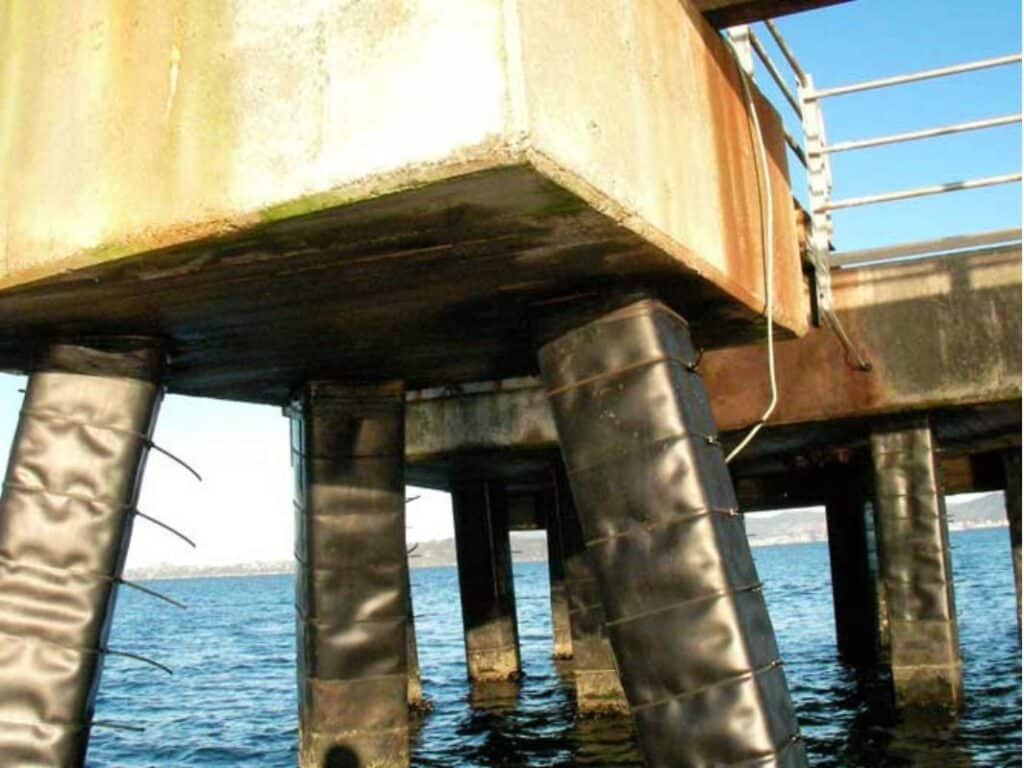
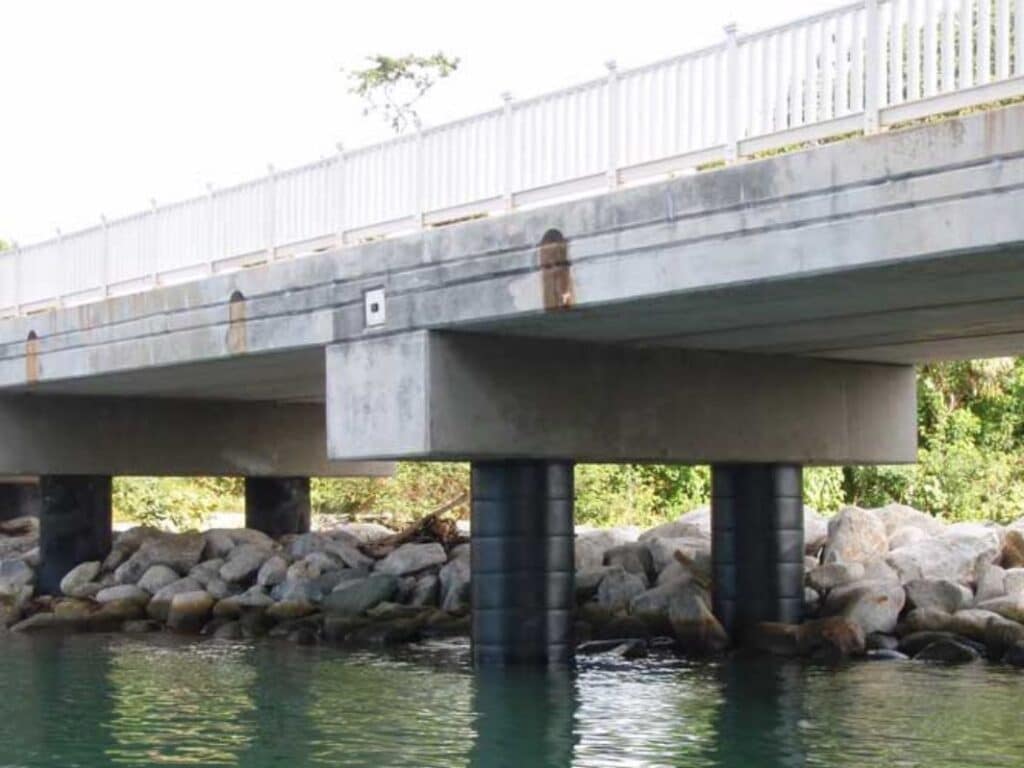
Ultimate Steel and Concrete Pile Protection System
For the most aggressive marine environments, an ultimate protection system provides an unparalleled solution. Designed to accommodate cylindrical and octagonal pile configurations, this system is applied using a controlled tensioning process, ensuring a secure fit and maximum protection. It offers unmatched resilience against the toughest marine conditions.
Key Benefits:
- Superior protection for complex pile geometries.
- Controlled tensioning for a secure and custom fit.
- Ideal for the most challenging marine environments.
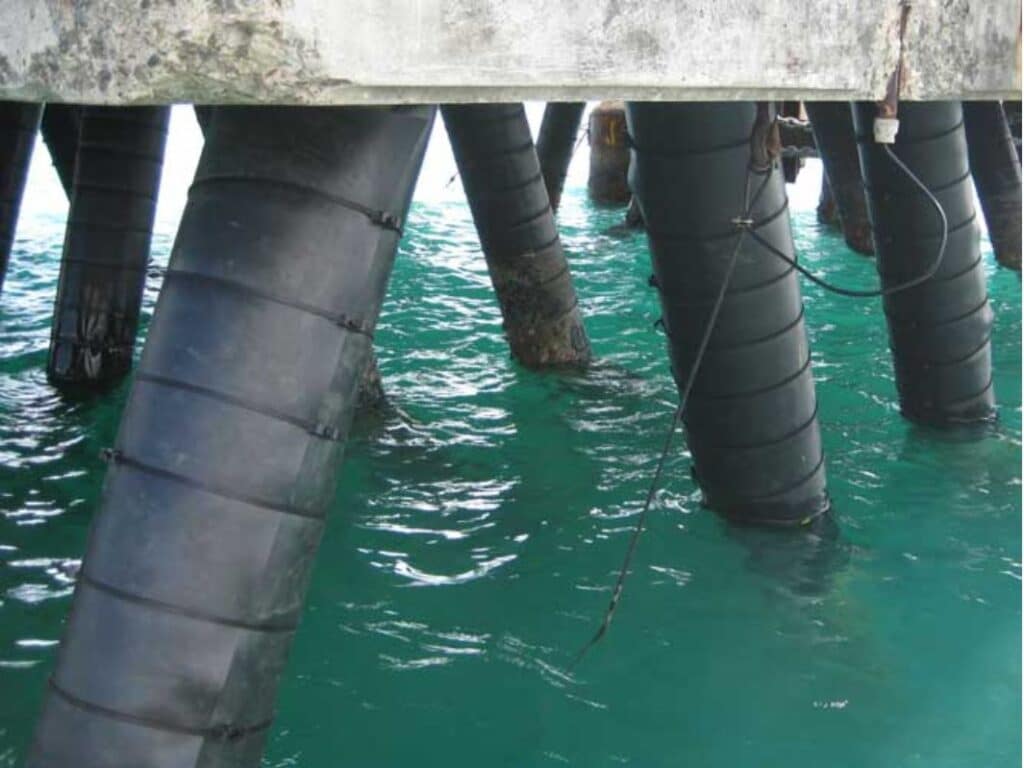
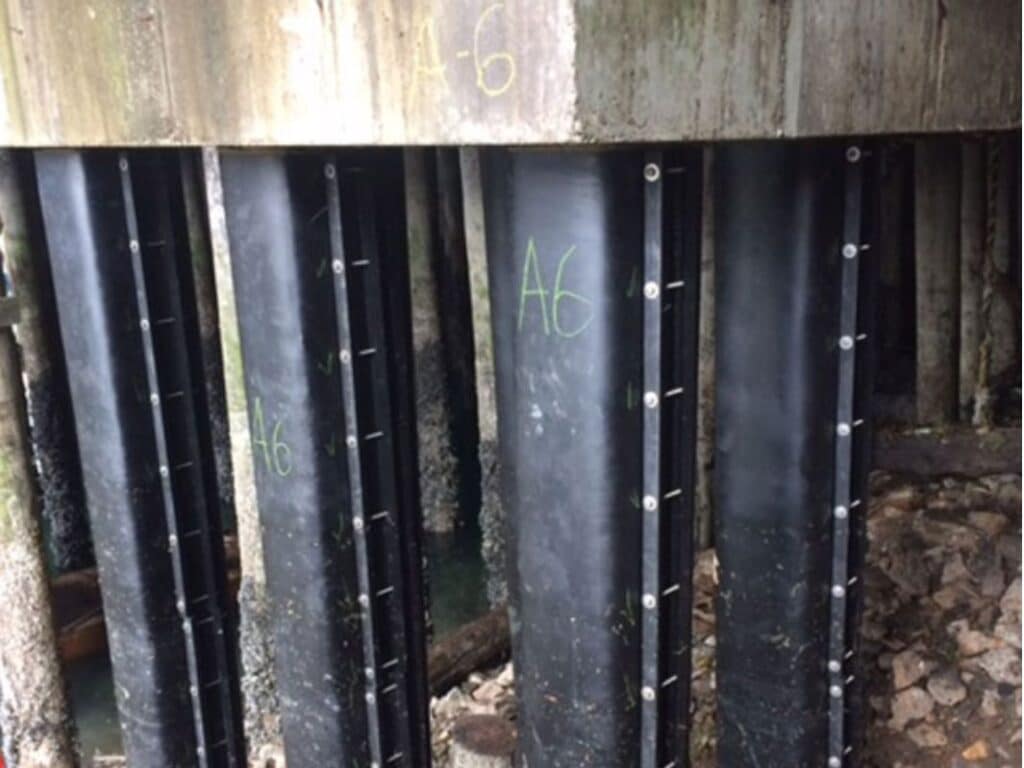
Versatile Steel, Concrete & Timber Pile Protection System
A versatile protection system suitable for steel, concrete, and timber piles is essential for comprehensive protection. This system uses marine-grade petrolatum tape and an HDPE outer cover, secured with a strapping system. By effectively sealing out oxygen and water, it stops corrosion in its tracks, preserving the integrity of metal surfaces and preventing spalling and corrosion in concrete piles.
Key Benefits:
- Multi-material protection (steel, concrete, timber).
- Effective corrosion prevention.
- Simple and effective installation.
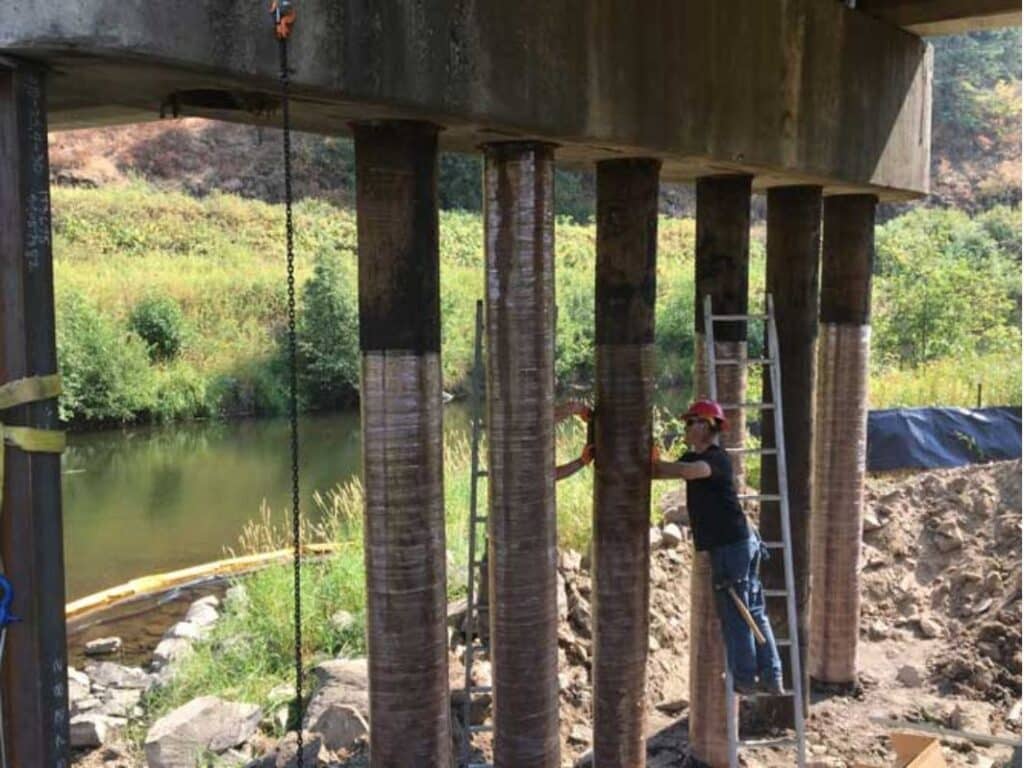
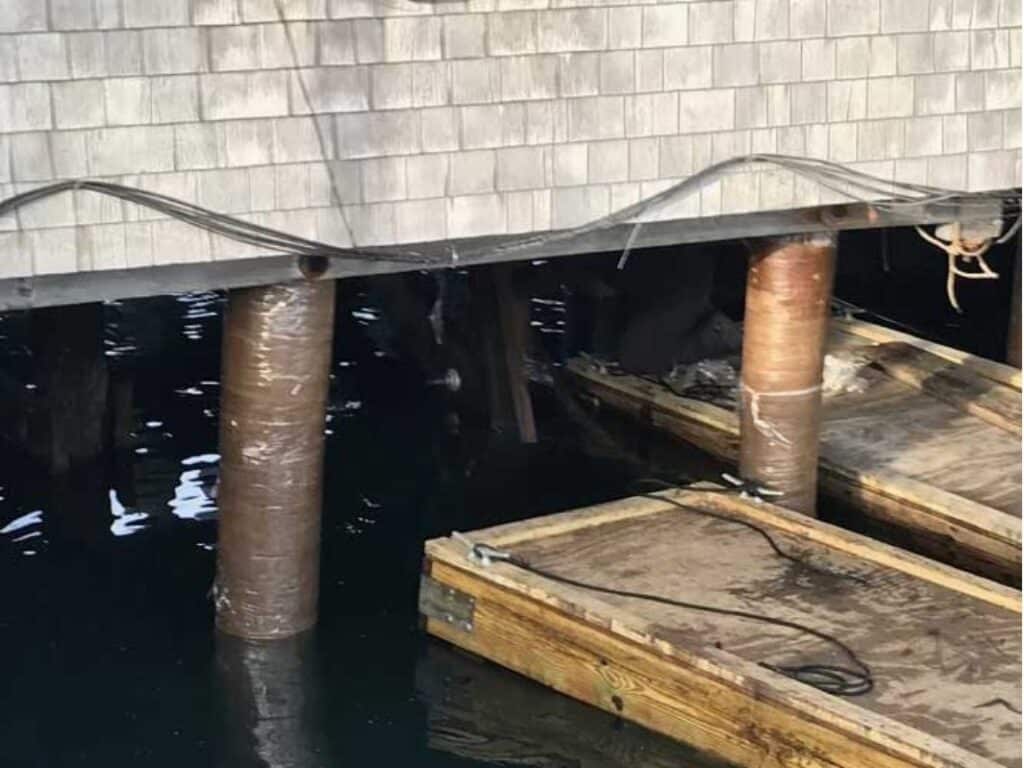
Durable Fiberglass Wrap System
For structures requiring additional strength and durability, a fiberglass wrap system offers a robust solution. This system combines an inner layer of marine-grade petrolatum tape with a moisture-cured resin-impregnated tape outer layer. Designed to accommodate both new and existing timber piles, this system also prevents corrosion in steel and concrete piles.
Key Benefits:
- Strengthens and protects timber piles.
- Versatile application for new and existing piles.
- Superior corrosion resistance.
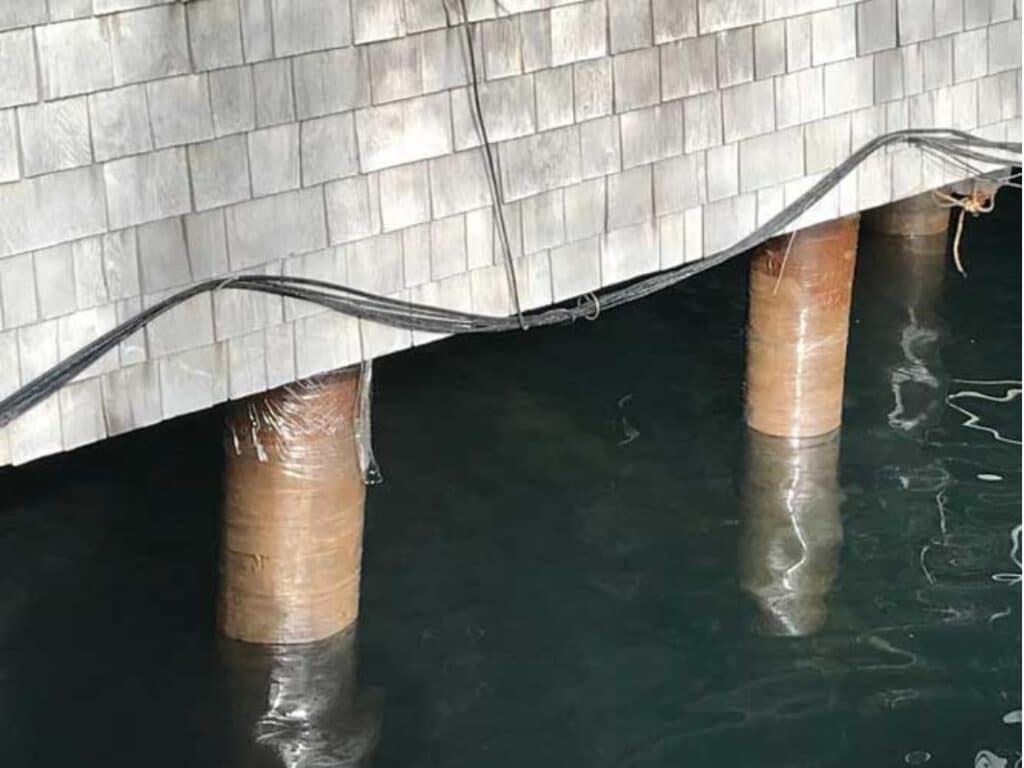
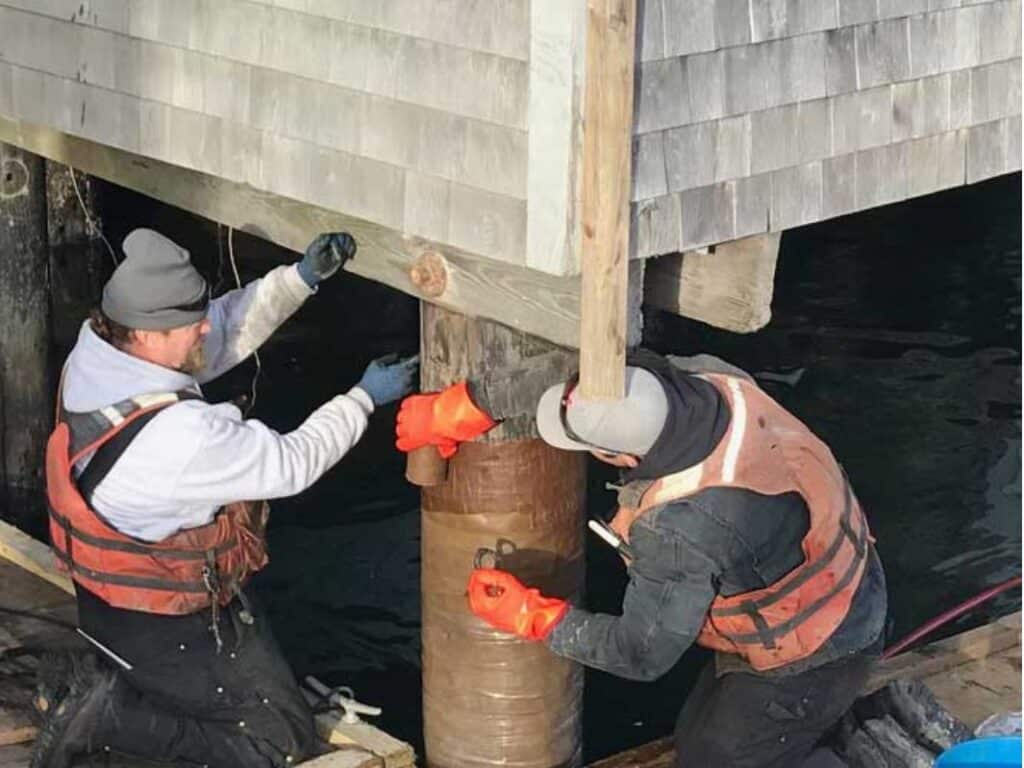
Specialised Timber Pile Protection System
Specialized protection for timber piles against marine borer destruction and weathering is crucial. Using marine-grade petrolatum tape and an outer cover, this system is designed to extend the life of timber piles in marine environments, preventing deterioration due to biological and environmental factors.
Key Benefits:
- Comprehensive protection against marine borers.
- Prevents weathering and deterioration.
- Enhances the longevity of timber piles.
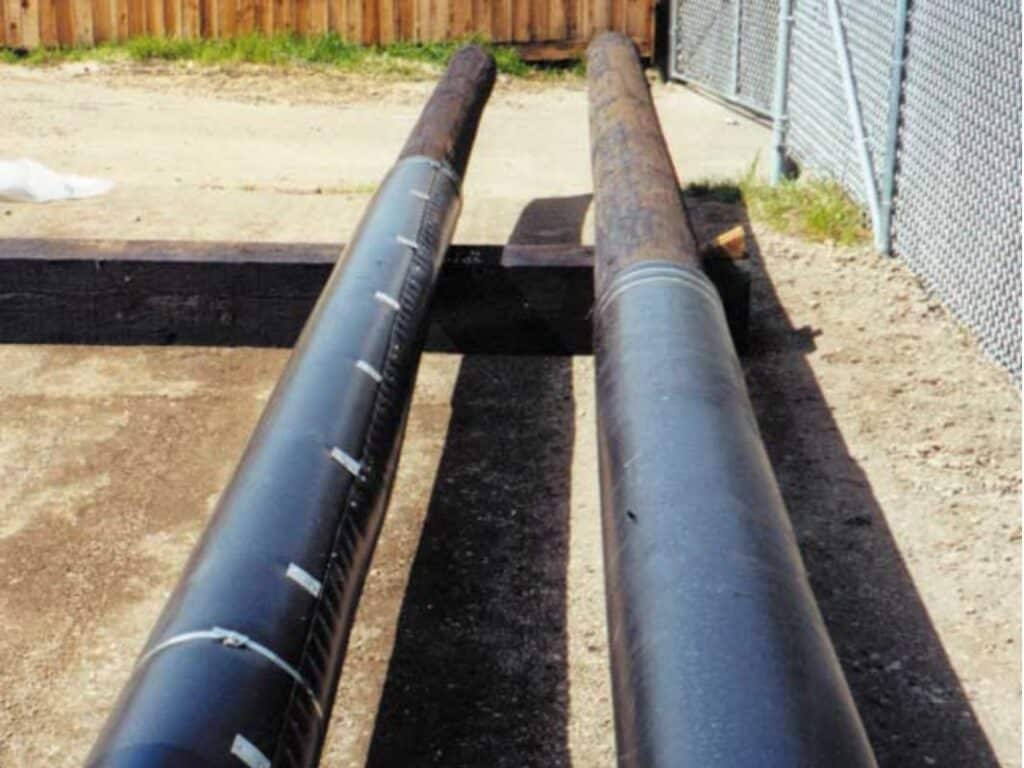
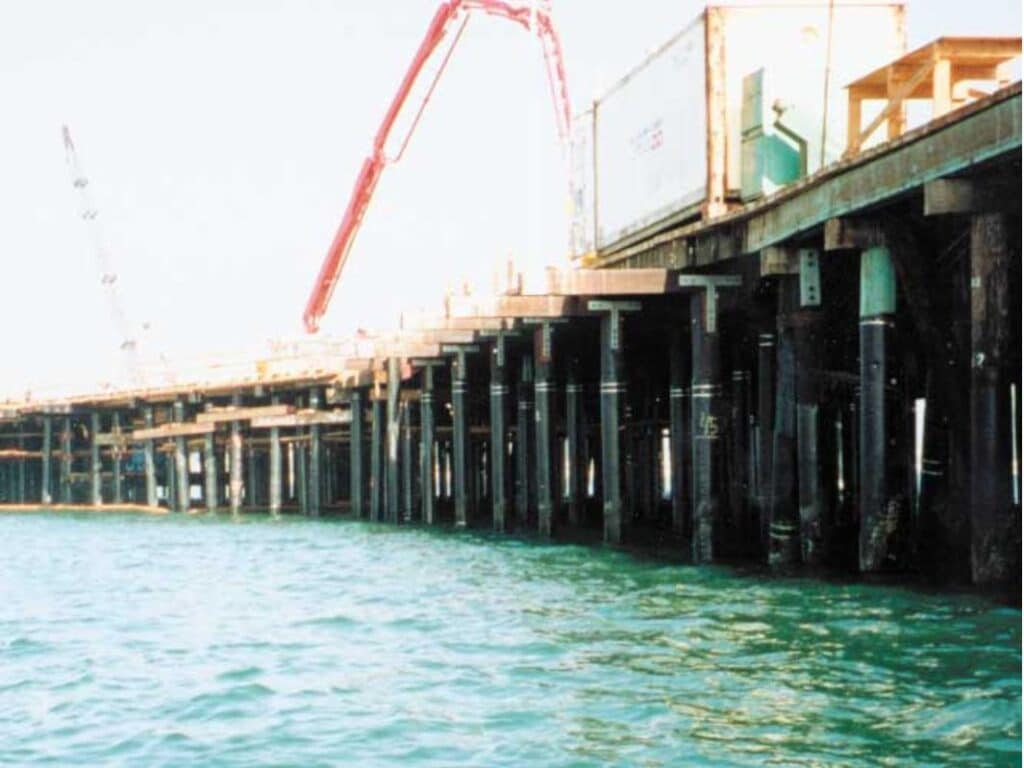
Non-Corrosive Structural Repair for Timber Piles
For timber piles in need of structural repair, a non-corrosive repair system offers a solution that doubles the strength of the original pile. This system utilises advanced materials and epoxy grout formulations, providing a robust repair that enhances the structural integrity of timber piles while resisting corrosion.
Key Benefits:
- Strengthens and restores damaged timber piles.
- Non-corrosive materials for long-lasting repairs.
- Enhances the structural integrity of existing piles.
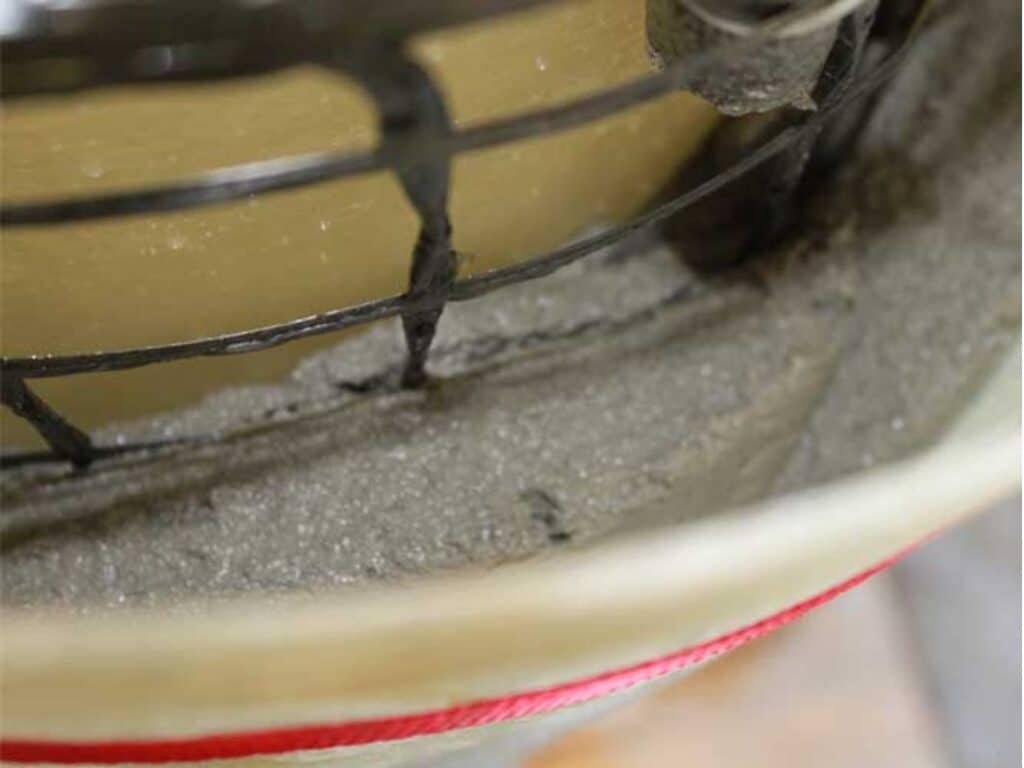
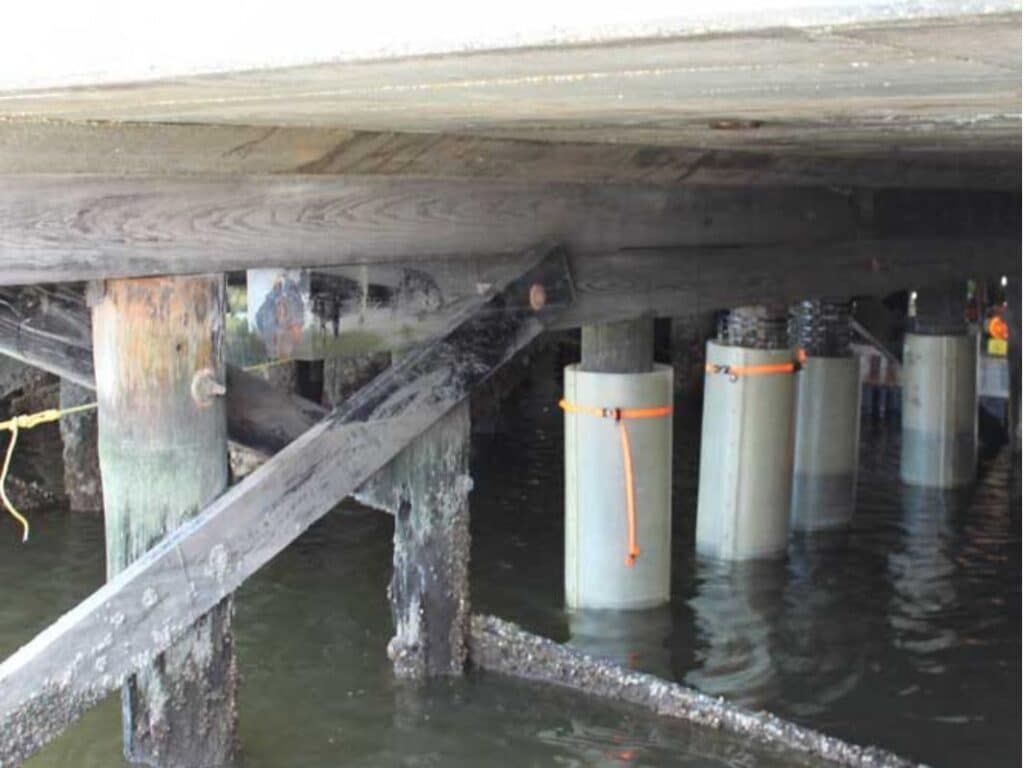
Carbon Fibre Pile Protection System
Carbon fibre reinforced polymer (CFRP) systems offer an advanced method for strengthening concrete piles. CFRP sheets or plates, made of high-strength carbon fibres in an epoxy resin matrix, are bonded to pile surfaces, enhancing flexural, shear, and fatigue strengths.
Key applications for piles include reinforcing marine piles against corrosion and impact, increasing the load-bearing capacity of existing piles, repairing damaged or deteriorated piles, and enhancing resistance to seismic forces. These versatile applications make CFRP systems an invaluable solution for a wide range of pile reinforcement needs in marine and coastal environments.
Key Benefits:
- Rapid installation with minimal downtime
- Non-invasive application preserving pile integrity
- Superior corrosion resistance in marine environments
- High fatigue resistance for long-term durability
CFRP strengthening provides an economical solution for improving pile strength and longevity, making it a preferred choice over traditional methods like steel jacketing in marine and coastal structures.


Conclusion
In the world of marine construction, the integrity of your piles is paramount. Understanding that piles are the crucial link between structures and the earth beneath, especially in weak soil conditions, highlights the importance of their protection. By investing in advanced pile protection and repair systems like those outlined above, you can ensure that your marine structures withstand the test of time, even in the most challenging environments. From heavy-duty protection for steel and concrete piles to specialised solutions for timber, these systems offer the durability and reliability you need to protect your investment.
For expert Marine Piling and Pile Protection services, including innovative solutions for longevity and durability, contact Structural Repairs. Our comprehensive range of services covers pile protection, repair, carbon fibre reinforcement, and various marine repair solutions. With extensive experience and cutting-edge techniques, we provide tailored services to meet your specific marine construction needs. Whether you require pile reinforcement, corrosion protection, or seismic retrofitting, don’t wait until it’s too late – reach out to Structural Repairs today to safeguard your valuable marine infrastructure and ensure its long-term integrity.